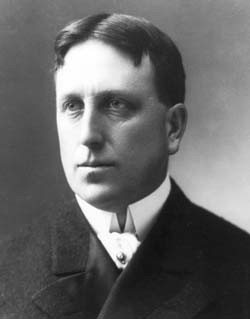If it had not been for media mogul William Randolph Hearst, New Salem State
Historic Site might still be a cow pasture.
In 1906 Hearst was a wealthy New York congressman who owned several newspapers and had hopes of becoming president. On August 17, he stopped here while traveling back to New York from his childhood home of San Francisco, where he had been helping victims of that April’s catastrophic earthquake and fires, (according to Ben Procter’s William Randolph Hearst: The Early Years, 1863-1910).
Officially, he was here to speak at Petersburg’s Old Salem Chautauqua, a summer festival of speakers and entertainers that drew
100,000 visitors at its peak and was located across the river from Lincoln’s old village, according to A Chautauqua to Remember: The Story of Old Salem, by Katharine Aird Miller and Raymond H. Montgomery (Silent River Press, 1987).
Hearst talked about “Political Independence,” according to the Aug. 18, 1906, Illinois State Register.
While here, Hearst surprised his audience by buying the land where New Salem
once stood and giving it to the Chautauqua‘s leaders for preservation. New Salem, the pioneer village where Lincoln lived
from 1831 to 1837, had become livestock fodder by then, according to Miller and
Montgomery‘s book. “Salem Hill,” as it was called, was “a cow and hog pasture, in which the only semblance of what it had once been were
the depressions marking where the cellars and buildings once stood…”
Montgomery, who, with his co-author, researched documents and interviewed area residents who lived during that time, has a theory about why. First, he says, Hearst was a philanthropist who helped many groups. Second, he could afford the $11,000 or $12,000 (accounts vary) pricetag. But most importantly, Montgomery believes, it would help his presidential aspirations.
Prior to Hearst, the land was owned by Petersburg’s Bale family, who were being pressured by “a group from Springfield” to sell it, Montgomery says. “The story that’s told, and I’m not sure it’s absolutely correct, is the Bale family supposedly didn’t want this to be turned over to a group to make a beer garden out of it.” They wanted it to become a Lincoln memorial. So they sought help from the Chautauqua leaders, which included influential people, according to Montgomery.
Some of those leaders met with the powerful central Illinois Congressman Henry T. Rainey, from Carrollton, in 1905. (Rainey was a Chautauqua supporter and spoke at the festival that summer.) Montgomery thinks the group asked him for help in preserving the pioneer village site and he then approached Hearst about buying the land. Doing so could help Hearst get Rainey’s support in Congress and for a presidential bid, plus it would win the hearts of Illinoisans, which wouldn’t hurt in a national campaign.
When Hearst arrived in Petersburg that hot August morning in 1906, Chautauqua leaders met him at the railroad station and immediately took him to Salem Hill, according to Montgomery and Miller‘s book.
After Hearst spoke at the Chautauqua that afternoon, Rainey announced his gift of the New Salem land to the Chautauqua association. The 8,000-member audience responded with “tumultuous applause,” according to the Aug. 18, 1906, Illinois State Register, which predicted that Chautauqua would establish its summer schools there, and build a ferry across the adjacent Sangamon River as well as a bridge named after Hearst.
Instead, the land sat fallow for about 10 years, even though Hearst stipulated
that the land would become his if the Chautauqua association did not use it as
he wished.
“In 1917, the Old Salem Lincoln League was formed at Petersburg, to carry on
research work (on the pioneer village site) and keep alive the interest already
aroused,” says 1934 state records about New Salem’s restoration. “The Chautauqua association, with Mr. Hearst’s consent, conveyed the site to the State of Illinois to be used as a State
Park, and in 1918 the League, with funds raised by popular subscription,
erected several cabins on original sites, built a road, marked other cabin
sites and in celebration of the occasion, gave a pageant depicting scenes of
pioneer days.”
When Hearst approved the Chautauqua association’s proposal to give the land to the state for a park, he “indicated he wanted the park to be forever free,” Montgomery says.


